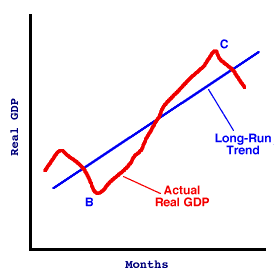
|
|
BUSINESS CYCLE: The recurring expansions and contractions of the national economy (usually measured by real gross domestic product). A complete cycle typically lasts from three to five years, but could last ten years or more. It is divided into four phases -- expansion, peak, contraction, and trough. Unemployment inevitably rises during contractions and inflation tends to worsen during expansions. To avoid the inflation and unemployment problems of business cycles, the federal government frequently undertakes various fiscal and monetary policies.
Visit the GLOSS*arama
|
|


|

|
                           RECOVERY: The early phase of a business-cycle expansion that occurs shortly after a contraction has ended. During a recovery, the unemployment rate remains relatively high, but is beginning to fall, and real gross domestic product begins to increase, usually rapidly. However, because the contraction remains fresh in the minds of many, it may not be immediately clear that the trough of the contraction has actually ended. A business-cycle recovery is a transitional period in which the economy is beginning an expansion, but many of the problems of the preceding contraction continue to linger. The unemployment rate generally remains at or close to their contractionary highs, but it is falling. Aggregate production remains low, but it is rising. The public is "guardedly optimistic" during a recovery, hoping but not absolutely certain that the contraction has ended and that an expansion is underway. Leading indicators might suggest that the economy is heading into an expansion, but a clear confirmation usually occurs only several months after the fact. A Graphical Highlight| Moving On Up |  |
The diagram at the right presents a simple business cycle. The red line represents the value of real gross domestic product (real GDP) over a period of several months. The blue line is potential real GDP, the amount of real GDP that the economy can produce by fully employing all resources.Click the [Recovery] button to highlight the early recovery of the expansion phase of this business cycle. The shaded segment of the real GDP line between points B and C is the expansion. Clearly real GDP increases over this segment. The early portion of this expansion, near the business-cycle trough, is the recovery. While there is no official designation of a recovery like there is for expansion and contraction, that portion of real GDP between point B and the blue long-run trend line of potential real GDP can be thought of as the recovery. Over this segment, real GDP lies beneath the long-run trend line and is moving back to potential real GDP and full employment. While it is graphically convenient to mark the end of the recovery by the intersection of the red actual real GDP line and the blue potential real GDP line, there is seldom a clear-cut end to a recovery like there is for a contraction-ending trough or an expansion-ending peak. A recovery is merely the early part of an expansion. Identifying the end of a recovery is much like identifying the end of childhood when a child becomes an adult.

Recommended Citation:RECOVERY, AmosWEB Encyclonomic WEB*pedia, http://www.AmosWEB.com, AmosWEB LLC, 2000-2025. [Accessed: July 18, 2025].
Check Out These Related Terms... | | | | | | | | | |
Or For A Little Background... | | | | | | |
And For Further Study... | | | | | | | | | | |
Related Websites (Will Open in New Window)... | | | |
Search Again?
Back to the WEB*pedia
|



|

|
PURPLE SMARPHIN
[What's This?]
Today, you are likely to spend a great deal of time flipping through mail order catalogs trying to buy either a flower arrangement for your aunt or a birthday greeting card for your uncle. Be on the lookout for rusty deck screws.
Your Complete Scope
This isn't me! What am I?
|

|
|
The portrait on the quarter is a more accurate likeness of George Washington than that on the dollar bill.
|

|
|
"A winner is someone who recognizes his God-given talents, works his tail off to develop them into skills, and uses those skills to accomplish his goals. " -- Larry Bird, basketball player
|

|
AFBD
Association of Futures Brokers and Dealers (UK)
|

|
|
Tell us what you think about AmosWEB. Like what you see? Have suggestions for improvements? Let us know. Click the User Feedback link.
User Feedback
|


|


